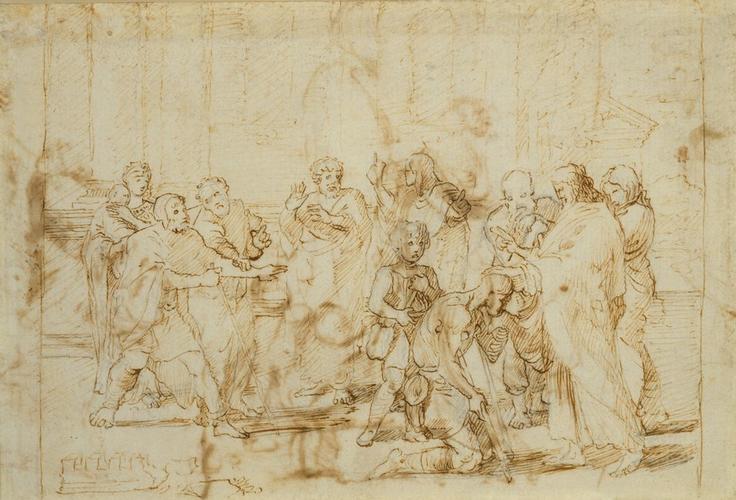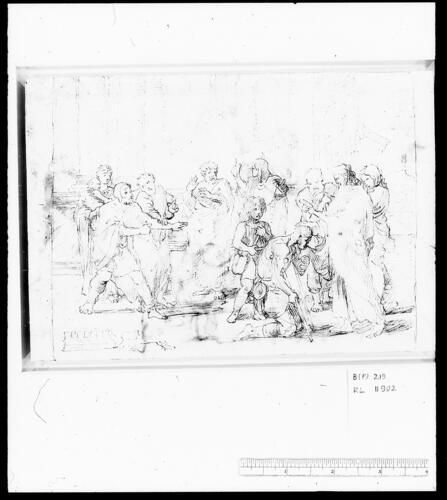Christ Healing the Blind c.1636 and c.1650
Graphite underdrawing, pen and brown ink, | 15.1 x 22.0 cm (sheet of paper) | RCIN 911902
-
A drawing of Christ healing a man kneeling before him; another blind man approaches; other figures standing around, before a colonnaded building. The drawing is a study for the painting of Christ Healing the Blind in the Louvre, painted in 1650. Although it has the appearance of a definitive composition, the drawing it is actually quite some distance from the final design - only the figures of the mother and child at the left and the disciple restraining the second blind man are found in the painting; the group of three standing figures on the right is retained, but with the place of Christ taken by a disciple.
Three other autograph studies for the painting survive. A sketch in Bayonne (Rosenberg & Prat 1994, no. 345), although much rougher, is actually closer to the painting in some respects than the present drawing, especially in the figure of Christ. What may be two sheets of life drawings for the composition are found on the verso of RCIN 911906 and on a sheet in the British Museum (1895.9.15.925 verso). There are also two copies at Windsor after drawings for the project, one very feeble (RCIN 911900), the other more robust (911901, attributed to Poussin himself by Rosenberg & Prat 1994, no. 69) – the manner in which both these elaborate drawings stop dead at the edges of the dense groups of figures suggests that they are partial copies of more extensive compositions.
The Bayonne sketch shows only a single blind man, suggesting that the precise subject had not been fixed; an objection that the crutches of the first man in the present drawing indicate that the episode is the healing of the cripple, rather than the blind, is countered by the emphasis on the man making contact with Christ by touching his robes, and by the presence of the young guide and the second blind man). The Gospels refer to two miracles involving the healing of the blind, in John (9:1-7) where Christ cures a single man at Capernaum, and in Matthew (20:29-34) where two are healed outside Jericho.
Assuming that Poussin followed the Biblical text accurately, the drawing ad painting, with two blind men, must be the Jericho episode, and it was described as such by Bellori (Le Vite de Pittori, 1672, pp.452f) and Félibien (1725, IV, p.61). The alternative identification of the scene was suggested at a meeting of the French Academy in 1667, after a lecture by Bourdon which featured a lengthy analysis of the painting. Highly praised in the lecture was the depiction of the various psychological responses to the event, which are shown rather more strongly in the preparatory drawings than in the painting; one particularly effective motif here which did not survive into the painting is the young guide of the first blind man, looking on with alarm as he sees his livelihood disappearing. This concentration on the expression of individual emotion is found too in Poussin's model for the composition, Raphael's design for the tapestry of the Blinding of Elymas (RCIN 912750, 912948). Poussin's interest in Raphael's tapestry series around this time is shown further by the derivation of his Death of Sapphira from Raphael’s Death of Ananias, and by a number of sheets of head studies (mostly known from copies) which include expressive heads taken from various of the tapestry designs.
On the verso of the sheet are drawings from much earlier in Poussin's career. The two larger sketches, showing a nymph garlanding a herm, are early studies for the Richelieu Triumph of Pan (see 911905, 911995), delivered in May 1636. The slighter sketch to the left is for the woman behind the candle-bearer in Extreme Unction, one of the set of Sacraments painted for Cassiano dal Pozzo (see 911896, 911894). The fact that recto and verso are of such different dates should caution against assuming that the sketches on the present verso are all of the same date, but the style and ink are identical and it appears that they were executed in quick succession. If correct, this gives an important terminus ante quem for the conception of the first Sacraments, for it demonstrates that Poussin was already studying individual figures by late 1635 or early 1636, though the style of the paintings suggests that they were painted a little later; it may be that his friend Cassiano allowed him to postpone the execution of the Sacraments when he received the commission for the Bacchanals from a patron as important as Cardinal Richelieu.Provenance
Probably Cassiano dal Pozzo (1583-1657); from whose heirs bought by Pope Clement XI, 1703; passed to his nephew, Cardinal Alessandro Albani, 1714; from whom acquired by George III, 1762
-
Creator(s)
Acquirer(s)
-
Medium and techniques
Graphite underdrawing, pen and brown ink,
Measurements
15.1 x 22.0 cm (sheet of paper)
Other number(s)
RL 11902










